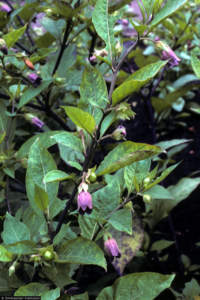
Deadly Nightshade (Atropa belladonna)
Photo credit: Smithsonian Institution
(https://www.fs.fed.us/wildflowers/ethnobotany/
Mind_and_Spirit/images/solanaceae/belladonna/
Atropa_belladona_Smithsonian_lg.jpg)
“It’s the pink one.”
One evening, three students gained unauthorized access to the restricted ingredients closet from which they retrieved dried Psilocybe semilancreata. They added the mushroom to some soup and sampled their concoction several times to see if the mushroom had any effects. Finally, one of them said, “I don’t feel a thing.” Another said, “I haven’t noticed any effect either.” The third student admitted, “I’m feeling a little giddy.” Meanwhile, another student, unaware of the extra ingredient, also ate some of the soup. Soon afterwards, this student became increasingly anxious and began to panic. (Excerpt from Homo transformans: The Origin and Nature of the Species.)
Introduction
All drugs are poisons – including over-the-counter, herbal, and homeopathic agents. The effects of an individual agent will be affected by the amount taken (dose); interactions with other agents, including foods; and the individual’s ability to utilize and subsequently break down (metabolize) the agent. These are not trifling matters.
Know your medications
Read the label. Most over-the-counter (OTC) medications have information on their label regarding the drug, including its intended effects, dose, side effects, and precautions – usually in microscopic print. Use a magnifying glass, if necessary, and read the information. Most prescription (Rx) medications now come with detailed information – sometimes two or three pages of it. If the drug is one you have not taken previously, read through the information the first time. Not only will you learn about the drug, you will also be alerted to potential side effects and interactions with other drugs or agents you may be taking.
Medication Reconciliation
Take all medications, both prescription and over the counter drugs, to any visit with a healthcare provider. This is especially important if you have more than one healthcare provider ordering medications for you. All drugs should be in their own labelled prescription bottles. You have no idea how many little blue, pink, yellow, and even purple pills there are! If you are asked why you brought all your medications, say the magic words “medication reconciliation”.
To the extent possible, use the same pharmacy for all of your prescription medications. Pharmacies have access to a computerized database that can check for drug-drug interactions among any of your medications provided they were filled within that pharmacy or pharmacy chain. These systems will raise a red flag when they detect a potential drug interaction.
Ask Your Healthcare Provider. If you receive a medication you think you should not have or do not need, contact your health care provider. Many medications have been found useful for treating problems beyond those for which they were developed originally. For example, gabapentin was developed to treat seizure disorders, and its information sheet still lists that as its primary indication. It is commonly used now to treat peripheral nerve pain. When in doubt, ask the healthcare provider who prescribed the drug. Be sure that your provider also knows what other agents you are taking.
Ask Your Pharmacist. Pharmacists are healthcare professionals that have specialized in the study of both prescription and nonprescription drugs. They are excellent sources of information when you have questions about a medicine. If the pharmacist suspects an issue with a prescription, he or she will contact the ordering provider for clarification of the prescription or acknowledgement that the prescription is correct.
January 12th is designated National Pharmacist Day. This is in recognition of the important role pharmacists have in delivering safe and effective healthcare. They are worth their weight in gold!
Additional Resources
Reliable resources for drug information include, but are not limited to:
- MedlinePlus – Health information from NIH and the National Library of Medicine – Drugs and Supplements https://medlineplus.gov/druginformation.html.
- Drugs.com https://www.drugs.com which offers features for identifying a pill and checking for interactions.
- WebMD Drugs & Medications A-Z http://www.webmd.com/drugs/2/index which also offers features for identifying a pill and checking for interactions.
- FDA Medication Guides https://www.fda.gov/Drugs/DrugSafety/.